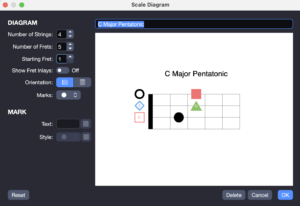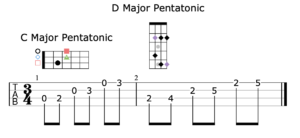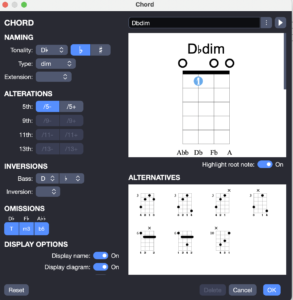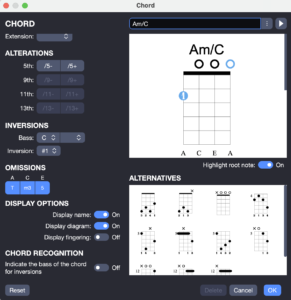Tracklist
Stables – Solstice Soufflé
Laura Currie & George Hinchliffe – Johnny B Goode
Amanda Shires & Jason Isbell – Mineral Wells
Bobby Alu & Foloi Iulia – Si Fe’e (Story of the octopus & the rat)
Jim Boggia – Tenth Avenue Freezeout
George Elmes – Firefinger
Honoka – Ku’u Lei Puakenikeni
Allison Young & Joshua Lee Turner – Samba Ukulele (Thanks to Colin)
Tyrone and Lesley – Ending
Emily Elbert + Jacob Collier – Not Alone
Guitar Pro has been my tabbing software of choice since I started Uke Hunt fifteen years ago. So the release of a new version prompts equal parts excitement and fear at Woodshed Towers. I’ve been using Guitar Pro 8 for a few weeks now (on a Mac) so I thought I’d share my experience with it (I’m a Guitar Pro affiliate in case that changes your opinion).
Should You Buy It?
If you’re starting fresh and wondering whether to buy Guitar Pro 8, I’d highly recommend it. I’ve done hundreds of tabs with it and have never been tempted to switch. It’s a well supported app and has regular updates between versions (e.g. I’ve been using GP7 and GP8 on Apple silicon without a hitch).
The one downside is the price. If you’re only doing occasional tabbing, MuseScore is a good free option (I only tried it briefly but it seems solid).
If you’re already a user and are considering upgrading from Guitar Pro 7, I think this upgrade is well worth the price. Other than a few bugs that will probably get worked out (there were a couple I was going to bitch about that already seem to have gone), it’s a solid improvement over GP7
The Good Stuff
Import Audio Files
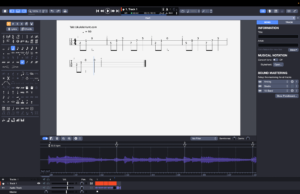 The tentpole feature of Guitar Pro 8 is the ability to add an audio track alongside the tab. Meaning you can listen to the song you’re tabbing along with what you’re tabbing. You can also slow down the track and transpose it (something I’d been using the app Capo for).
The tentpole feature of Guitar Pro 8 is the ability to add an audio track alongside the tab. Meaning you can listen to the song you’re tabbing along with what you’re tabbing. You can also slow down the track and transpose it (something I’d been using the app Capo for).
The intended use of this is to import the original track and tab from that. But because I’m often messing around with the arrangement, that doesn’t fit my workflow. So I’ve been importing the audio from my final recording. When I record the video, the tab can be anywhere from not even started to basically done. Whatever stage it’s at, I’ve found it incredibly useful to have the audio synced to what I’ve tabbed making it easy to spot errors or slight differences. This feature alone was worth the upgrade price to me.
The only gripe with this feature is that it’s tricky to sync with tracks that aren’t played to a click. You can drag the bar lines around so it matches with the tab, but if the tempo is drifting it’s fiddly to try to get things to match up.
Command Line Interface
Guitar Pro has an overwhelming number of options. Which can make it difficult to find what you’re looking for. Now you can type what you want to happen in the “Command Line”.
For example, say you want to transpose a part down seven semitones. You select the section you want to transpose, press command+e, type “transpose -7”, press return and you’re done. Or if you want to add an A7 chord above the tab, you press command+e, type >A7 and bingo.
There are already keyboard shortcuts for many of the things you might use this for. And it’s well worth learning those for things you do regularly. But I can see myself using this feature a great deal.
Scale Diagrams
GP8 lets you add scale diagrams above the tab similarly to chord diagrams.
There’s a huge range of options including different shapes and colours of markers and a choice of having the diagram horizontal or vertical. You can also type inside the markers. Although, as you can see from the screenshot, there does seem to be a bug with the text not displaying on open strings.
I don’t know if I’ll use it a whole lot but I can see it coming in handy. My only complaint is that the diagram is always six strings by default even when the track you’re adding it to doesn’t.
No New File Format
In the past, new versions of Guitar Pro have come with new file formats that aren’t backwards compatible. Mercifully, this time is different. It still uses the .gp file which can be opened by GP7 without any issues.
Little Improvements
– More layout options. You can now adjust the position of individual notes. There are a bunch of times in the past this would have come in handy for me.
– Transposing a tab can now transpose the chords as well.
– More export options.
– You can now make copy/pasting include chords by default.
– Visually, it’s very similar to GP7 but it has been freshened up.
– A bunch of stuff I’m never going to use like nest triplets and drum tabs.
Not So Good Stuff
Bluetooth Headphones
In my review of Guitar Pro 7, I complained that the app would crash every time I connected by bluetooth headphones. That never got fixed. And with GP8 it’s only been half fixed. Now, instead of crashing, it will mute the sound and put up a message. Maybe it’s something weird in my setup but I don’t have this problem with any other app I use.
Messed Up Chord Names
When you’re adding chords you can plug in the chord shape and Guitar Pro will automatically added the name of the chord. Mostly this works smoothly but sometimes it will go with odd or completely insane chord names. For example, putting in an A7 shape has given me Dbdim in the past.
Also, even with the option to include bass notes in the chord turned off, it will sometimes include bass notes in the chord (which you’d never want for ukulele chords).
The Beautiful South – A Little Time (Tab)
The Beautiful South are one of those bands that are so British I can’t imagine them making it huge around the globe. Nevertheless, they have some great tunes so I wanted to tab A Little Time. Plus what remains of The Beautiful South recent toured with, Uke Hunt favourites, Keston Cobblers’ Club.
There are a few tricky manoeuvers in this arrangement. But one simple thing is the chords. The intro, verse and solo all have just one chord: G.
There are a few challenging aspects. First is the speed of some of the notes. I use a lot alternate picking to get up to speed. Plus my version is slightly slower than the original (I think you could go even slower and get away with it).
The second bit that’s a challenge is using your pinkie to slide up from the 5th to the 7th fret. I definitely need more practice with that to be as confident as I am with other fingers.
But the part I had most difficultly with was the switch between the verse and chorus. In the original, this is where Briana Corrigan interrupts David Rotheray mid-sentence. An effective way to represent an argument in a duet but challenging to create a separation on the uke.
Links
Johnny Cash/Nine Inch Nails – Hurt (Tab)
This arrangement of Hurt is very much based on the Cash version. But I was a massive Nine Inch Nails fan as an angsty teen, so some of that version might have slipped through.
The plodding pace of this song makes it pretty easy to play. Just make sure you give the strings some welly in the chorus to recreate the thundering, steady pianos.
Links
Buy the Johnny Cash version
More country tabs and chords
Uke Hunt Patreon
Sorry for going AWOL this week. I’ve been under the weather recently and completely out of it most of the week. Hopefully I’ll be back in business before long.
Patreon
A massive thanks to all Uke Hunt’s Patreon backers for keeping the site up and running this month. And double thanks go to these legendary patrons of the arts:
– Arthur Foley
– Colleen Petticrew
– Dan
– Elizabeth Beardsley
– Fi Keane
– Jameson Gagnepain
– Jeff K
– Jon Kenniston
– Kelby Green
– Kie77
– Lisa Johnson
– Monika Kolodziejczyk
– Moses Kamai
– Nick Parsons
– Pat Weikle
– Pauline LeBlanc
– Robert
– T S
– Thorsten Neff
If you join Patreon at the Concert level or higher, you’ll get access to all previous exclusive tabs including June’s: Kate Bush’s Running Up That Hill:
Marvin Gaye – Let’s Get It On (Tab)
Here’s my take on Marvin Gaye’s Let’s Get It On. Although you could just tell people it’s Ed Sheeran’s Thinking Out Loud and no one will notice.
I recommend being relaxed and loose with the phrasing in this one. Being on the beat is not sexy! My phrasing is slightly different to Marvin’s and you should play it the way you feel it.
The trickiest parts of this arrangement are where you’re holding a Bb chord and also bending the E-string at the third fret (e.g. at the end of bar 1). You have to make sure you’re only bending the E-string and not the g- or C-strings. The good news is you only have to bend it slightly sharp. This mimics the original giving it a yearning feeling.
Links
Radiohead – Karma Police (Tab)
I’ve written up quite a few Radiohead songs in the past. Now it’s time for the OK Computer track Karma Police.
Intro: Mostly picking out the chords with the thumb on the C-string and the middle and index on the E and A, respectively.
On the Eb chord there’s a nice addition of an F note making it an Ebsus2. To prepare for the change to that, fret the E-string, third fret in the first half of the bar with your little finger.
Verse: Sticking with the same picking for the verse. The only slightly tricky part here is the run down from the fifth fret in bar 12.
Bridge: I’m mostly using one-finger-per-string picking in this section until the last two bars. There’s a lot more moving around the neck in this section, with the transition between bars 17 and 18 being tricky (I flubbed that bit in the video). Which is the most Radioheady part of the song.
Chorus: Even more moving around here, but it’s less intense.
Solo: The solo takes its inspiration from the bass line. There’s lots of scope for your own ideas here.
After that, it’s another run through the chorus and a fade out with a little of Freakshow Industries’ Backmask added.
Links
Buy the original
More Radiohead tabs and chords
Uke Hunt Patreon
The White Stripes – We’re Going to Be Friends (Tab)
Following on from These Days with another Cotten-picking arrangement: a rare White Stripes acoustic song We’re Going to Be Friends. But this is easier than These Days as the thumb alternating between the g- and C-strings through the whole song.
The melody is very simple and repetitive almost like a nursery rhyme. But there are slight variations between the verses that you need to include to create at least a little variety.
The only big variation comes in the bridge section where they go far out and include a fourth chord. But you’re still picking the same basic patterns.
Links
After Scott Morrison’s ill-advised ukuleling, the uke became a bit of a running theme in the Australian election with ukulele leaflets and losing MPs being dispatched by a ukulele robot overlord.
A bunch of ukulele groups have been doing great work raising money to aid Ukraine. If you want to give some direct help, give some support to Kharkiv-based ukers Alcohol Ukulele.
Martin have revealed a new range of tenor ukuleles.
Inevitably, NFTs have hit the ukulele world in form of UkeHeads. Like most NFTs, they’re hideous, procedurally generated monstrosities. But they do give you a chance to play on James Hill’s next album.
On Video
– An imaginative retelling of Jimi Hendrix finding a one-string ukulele and falling from the sky.
– Jimmy Buffett busts out his uke for a version of Margaritaville.
Patreon
A massive thanks to all Uke Hunt’s Patreon backers for keeping the site up and running this month. And double thanks go to these legendary patrons of the arts:
– Arthur Foley
– Colleen Petticrew
– Dan
– Elizabeth Beardsley
– Fi Keane
– Jameson Gagnepain
– Jeff K
– Jon Kenniston
– Kelby Green
– Kie77
– Leia-lee Doran
– Lisa Johnson
– Monika Kolodziejczyk
– Moses Kamai
– Nick Parsons
– Pat Weikle
– Pauline LeBlanc
– Robert
– T S
– Thorsten Neff
If you join Patreon at the Concert level or higher, you’ll get access to all previous exclusive tabs including May’s: Elizabeth Cotten’s Freight Train.

